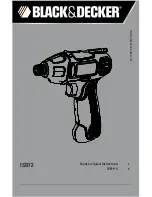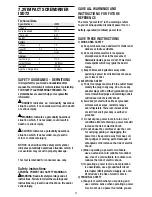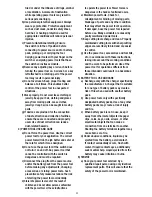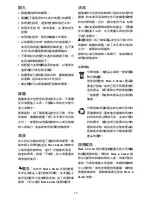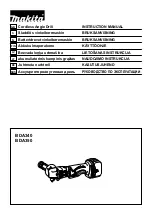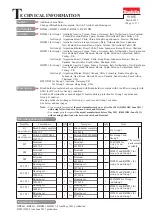
6
3. Do not expose charger to rain or snow.
4. Use of an attachment not recommended or sold
by Black & Decker may result in a risk of fire,
electric shock, or injury to persons.
5. To reduce risk of damage to electric plug
and cord, pull by plug rather than cord when
disconnecting charger.
6. Make sure cord is located so that it will not
be stepped on, tripped over, or otherwise
subjected to damage or stress.
7. An extension cord should not be used unless
absolutely necessary. Use of improper
extension cord could result in a risk of fire,
electric shock or electrocution.
a. Two-wire cords can be used with 2-wire or
3-wire extension cords. Only round
jacketed extension cords should be used,
and we recommend that they be listed
by Underwriters Laboratories (U.L.). If the
extension is to be used outside, the cord must
be suitable for outdoor use. Any cord marked
for outdoor use can also be used for indoor
work. The letters “W” or “WA” on the cord
jacket indicate that the cord is suitable for
outdoor use.
b. An extension cord must have adequate wire
size (AWG or American Wire Gauge) for safety,
and to prevent loss of power and overheating.
The smaller the gauge number of the wire, the
greater the capacity of the cable; that is, 16
gauge has more capacity than 18 gauge. When
using more than one extension to make up the
total length, be sure each extension contains at
least the minimum wire size.
Chart for minimum wire size (AWG) of Extension Cords
Nameplate rating AMPS – 0 – 10.0
Total Extension Cord Length (ft)
0-25
26-50
51-100
101-150
(0-7,6m) (7,6-15,2m) (15,2-30,4m) (30,4-45,7m)
Wire Gauge 18 16 16 14
8. Use only the supplied charger when charging
your tool. The use of any other charger
could damage the tool or create a hazardous
condition.
9. Use only one charger when charging.
10.Do not attempt to open the charger. There are
no customer serviceable parts inside. Return to
any authorized Black & Decker service center.
11.DO NOT incinerate the tool or batteries even if
they are severely damaged or completely worn
out. The batteries can explode in a fire.
12. Do not incinerate the battery even if it is
severely damaged or is completely worn out.
The batteries can explode in a fire. Toxic fumes
and materials are created when lithium ion
batteries are burned.
13. Do not charge or use battery in explosive
atmospheres, such as in the presence of
flammable liquids, gases or dust. Inserting or
removing the drill from the charger may ignite
the dust or fumes.
14. If battery contents come into contact with the
skin, immediately wash area with mild soap
and water. If battery liquid gets into the eye,
rinse water over the open eye for three minutes
or until irritation ceases. If medical attention is
needed, the battery electrolyte is composed of a
mixture of liquid organic carbonates and lithium
salts.
WARNING: Burn hazard. Battery liquid may be
flammable if exposed to spark or flame.
ChARGING PROCEDURE
ThE BATTERIES IN YOUR TOOL ARE NOT FULLY
ChARGED AT ThE FACTORY. BEFORE ATTEMPTING
TO ChARGE ThEM, ThOROUGhLY READ ALL OF
ThE SAFETY INSTRUCTIONS.
To charge your tool, follow the steps below.
1. Plug the charger (7) into electrical outlet.
2. Insert the charger into the charging port (5),
making sure to line up the keyed plug with
the port as shown in figure A. The charging
indicator LED (6) will flash, indicating the
battery inside the drill is being charged. The
completion of charge is indicated by the LED
remaining on continuously.
IMPORTANT ChARGING NOTES
1. Your tool was sent from the factory in an
uncharged condition. Before attempting to use
it, it must be charged for at least 9 hours.
2. DO NOT charge the batteries in an air
temperature below 40°F (4,5° C) or above 105°F
(40,5 °C). This is important and will prevent
serious damage to the batteries. Longest
life and best performance can be obtained if
batteries are charged when air temperature is
about 75°F (23,8° C).
3. While charging, the charger may hum and
become warm to touch. This is a normal
condition and does not indicate a problem.

